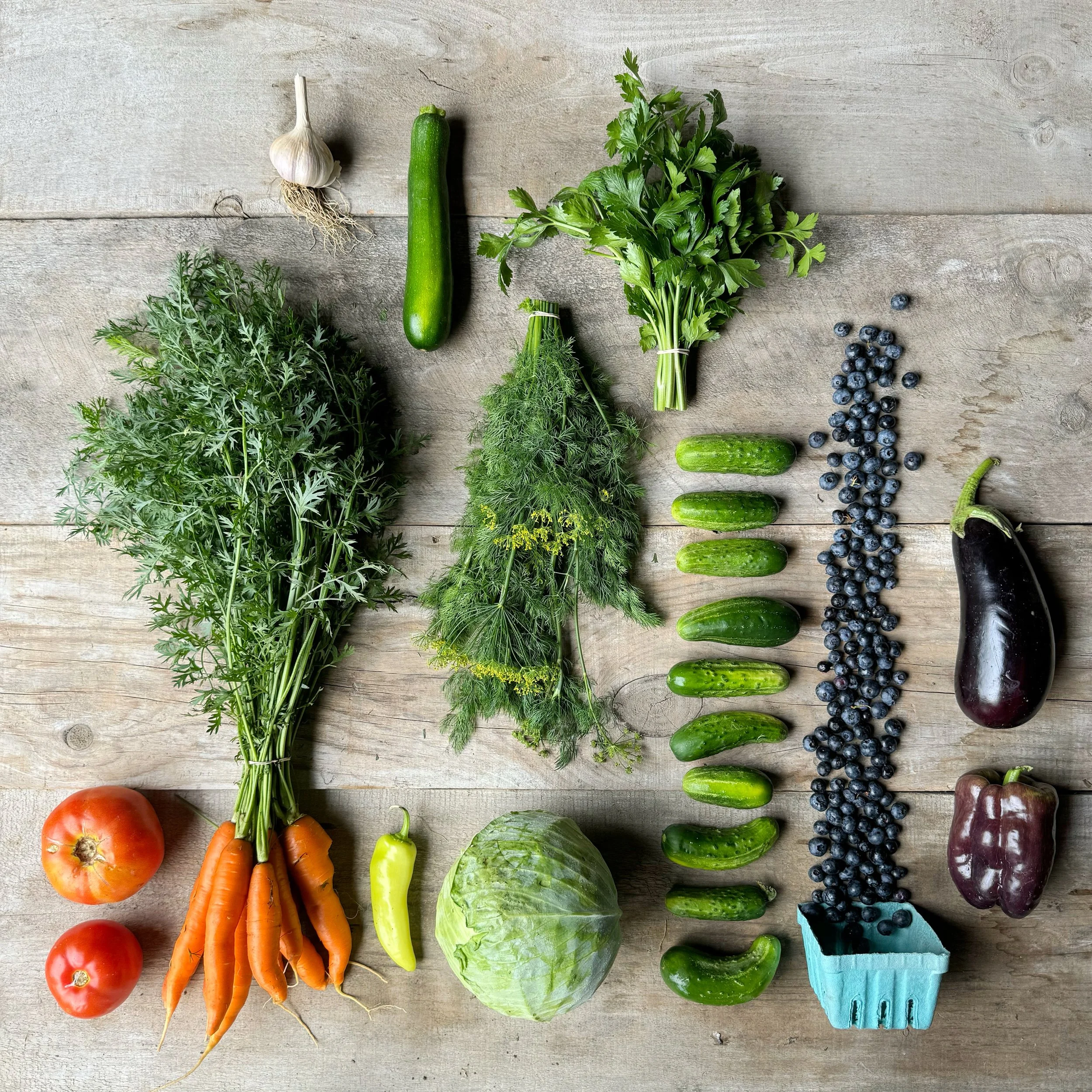P i c k l i s t
PICKLING CUKES - DILL - GARLIC - ZUCCHINI - FLAT PARSLEY - BLUEBERRIES - TOMATOES - PURLPLE PEPPER - HUNGARIAN HOT WAX PEPPER - EGGPLANT - CABBAGE - CARROTS
Edgewater update: This week in farming we *gasp* left the farm. This was such an ordeal and took just about everybody kicking in extra to make it happen. But somehow, by the grace of whomever and with the support of our field crew and our family, Ray the kids and I got to take in a real classic summer family vacay. Complete with a road trip, gas station snacks, jumping in water and laying on rocks. I was particularly pumped when our dear friends we were visiting gave us a detailed list of produce to bring from the farm. They asked for the most basic crops and whipped up the most decadent meals. Y'all know about the Niçoise salad? Uses just about everything we grow, plus proteins of your choice and drenches it in dressing. This might seem like basic child’s play to you all, but I am deep in the stage of the same foods on repeat and often leaning into hot dogs and cheese burgers for kiddos. It was pretty cool to see our crops come together at different tables and shine. Tastes damn good too.
But truly, Tim, Sarah, Mrs. T, Mike, and Anne really covered our butts so we could have a couple of days of off farm summer bliss. We all know the thrill of summer vacation, and it was good to dip our toes in it. We dove right back into the grind Tuesday morning. Picking for CSA, farmstand, and wholesale orders and marvelling at the most gorgeous bunches of dill I have ever known, and counting pickling cukes by the bushel.
And here we are now at the beginning of August when peppers start to ripen, and fingers crossed, melons aren't too far behind.
FARMY FOODIE PRO-TIPS:
Classic Sour Dill Pickles
YIELD: 1 GALLON This recipe was shared by Jeffrey Yoskowitz on https://www.jewishfoodsociety.org/
5 pounds whole unpeeled Kirby cucumbers (the smaller the better)
½ gallon filtered water
½ cup kosher salt
1 cinnamon stick
3 bay leaves (dried or fresh)
1 dried whole chile pepper
1 teaspoon whole coriander seeds
1 teaspoon yellow mustard seeds
1 teaspoon whole black peppercorns
½ teaspoon whole cloves ¼ bunch fresh dill, washed (leave the stems on)
1½ heads garlic, cloves separated and crushed
STEP 1: If desired, fill a large bowl or bucket with ice and water and place the cucumbers in it. Let sit for 45 minutes or up to 5 hours. This helps firm the cucumbers so they retain crunch during the fermentation process, but itʼs not absolutely necessary.
STEP 2: Fill a large ceramic crock or glass jar (gallon-size is ideal) halfway with the filtered water. Add the salt and stir until it has dissolved.
STEP 3: Add the remaining ingredients to the salted water, then add the cucumbers. Make sure the spices, herbs, and garlic are not simply floating on the surface.
STEP 4: Create a seal: If fermenting in a crock, use a plate or a wooden board to force the vegetables beneath the brine. If necessary, top with a clean glass growler or jar filled with water to ensure that the weight applies pressure on the vegetables, keeping them submerged. If fermenting in a jar, use a smaller jar filled with water to do the same (see page 45 for sealing instructions). Cover with a towel to keep out dust and bugs.
STEP 5: Let the soon-to-be-pickles sit at room temperature for 3 to 7 days. The longer they sit and ferment, the sourer they will become. At a stable room temperature, half sour pickles should take 2 to 3 days to ferment and full sour pickles should take 5 to 7 days (the amount of time may vary based on air temperature and even elevation). Youʼll notice that the pickles will turn paler as they ferment.
STEP 6: Once the pickles reach the desired flavor, remove any white yeast or mold (or moldy pickles) from the top of the vessel and discard them. Yeasts and molds are a natural part of the process and typically occur only on the surface, where oxygen meets the vegetables. Donʼt worry. Pack your pickles into smaller glass jars, then cover completely with brine and place directly in the refrigerator. They will keep in the refrigerator for up to 6 months.
Note that this recipe calls for an extended wait time of up to 7 days. Also, pickling your cucumbers whole increases the likelihood of a crunchy pickle. Slice or spear your cucumbers only once theyʼre finished for best results. The brine will likely look cloudy and a bit fizzy. Thatʼs 100 percent normal and healthy.
CREAMY COLESLAW/ 6 to 8 servings
extremely exuberant shout out to Janelle Wilson, who made this for a mass audience this past weekend while staring out at the water overlooking the 1000 islands and reminded me just how good a classic cole slaw can be
recipe from, The Joy of Cooking by IRMA S. ROMBAUER & MARION ROMBAUER BAKER
Remove the outer leaves and core from: I small head green or red cabbage (about 2 pounds) finely shred or chop by hand or in a food processor ( you should have 8 to 10 cups). Place in a deep bowl. Pour just enough Creamy Dressing for Coleslaw over the cabbage to moisten it. Toss well to coat.
Season with:
Salt and black pepper to taste. If desired, stir in any of the following:
1 to 2 teaspoons dill, caraway, or celery seeds, or a combination
2 tablespoons chopped parsley, chives, or other herb
3 to 4 strips crisp bacon, crumbled
1 cup pineapple chunks
½ cup grated carrots
½ cup coarsely chopped onions, bell peppers, or pickles
2 options for creamy coleslaw dressing.. yummmm
OPTION 1: CREAMY DRESSING FOR COLESLAW
Stir together until well blended:
¾ cup mayonnaise
¼ cup cider vinegar or rice vinegar
1 to 2 tablespoons sugar
OPTION 2: CREAMY HORSERADISH DRESSING
Whisk together in a small bowl:
4 teaspoons red wine vinegar
1 teaspoon salt
Gradually whisk in until well blended:
¼ cup olive oil
2 tablespoons vegetable oil
Stir in:
¼ cup heavy cream
2 tablespoons drained prepared horseradish
Salt and white pepper to taste

